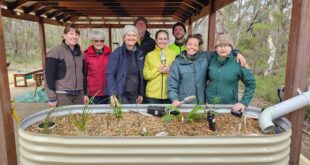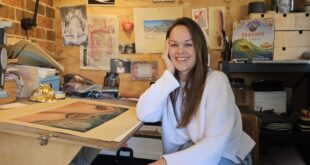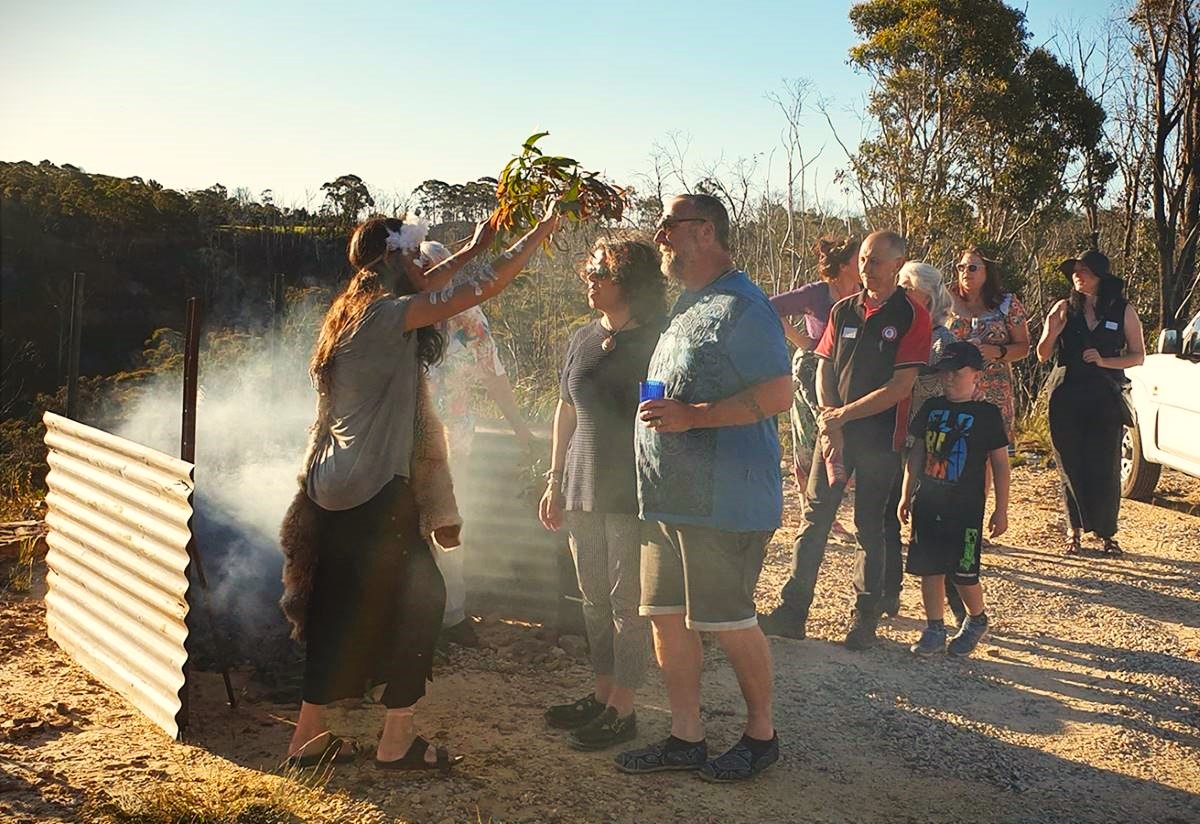
Aunty Sharon and Aunty Helen Riley perform a healing ceremony for residents a year after the Gospers Mountain bushfire devastated the community. (Image supplied)
Story by Hamish Dunlop
The community-driven post-fire recovery of Bell, Clarence and Dargan is extraordinary. Its success goes against what was believed to be possible. Find out how they did it here.
Key Points:
- The 2019/20 fires hit the three communities of Bell, Clarence and Dargan hard. Per capita, they experienced the greatest loss of houses across the Mountains and were among the worst hit communities on the East Coast of Australia.
- A group formed with representatives of all three communities as a way of responding to the devastation.
What is happening in Bell, Clarence and Dargan continues to prove that local communities can shape their own destinies. It is not a stretch to say that the model for this success is a gold standard in how community-driven recovery can take place.
To look through the latest Lyrebird Local (the Bell, Clarence and Dargan community newsletter) shows just how much has been achieved. In the last three months alone:
- The Lyrebird Spring Market has been held in collaboration with Zigzag Railway.
- The new community hall has progressed with the pouring of the slab and the installation of water tanks.
- The three further sessions by fire consultant Tony Hawkins were completed.
- The community came together for a successful Resilience Action Plan workshop.
- UHF radio training sessions have also been held in conjunction with Lithgow City Council and Habitat for Humanity.

A snapshot from the latest edition of The Local Lyrebird newsletter that informs and celebrates the communities.
Clarence resident Jeannie Dare says the regionally funded markets have been wonderful in how they’ve connected people. “Many people in the community seemed to enjoy the markets,” she says. “One of the best things for me was running into people I’d seen in the village. We’d discover we were both Clarence residents, and immediately there was a lot of common ground.”
A survey conducted by Sydney University concluded this was the case for many of the people who attended. Seventy percent agreed the event enabled them to reconnect with people in their community and make new connections.
The meeting of hearts and minds
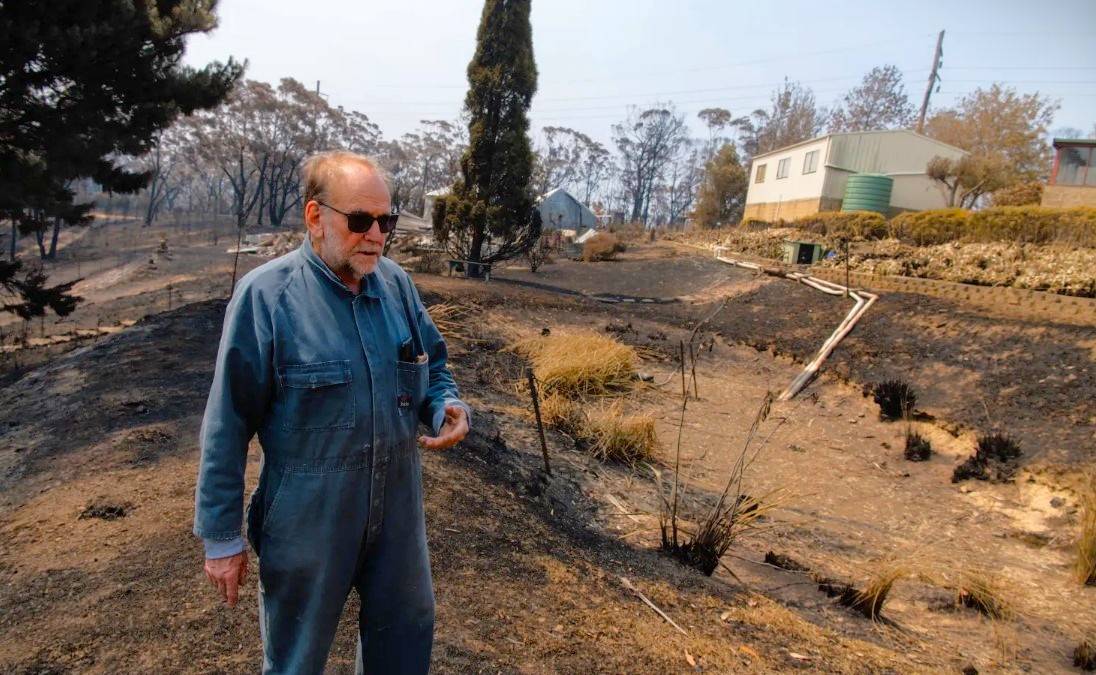
John Cornford at his home in Dargan after the 2019/20 fire. It survived while three surrounding houses burnt to the ground. (Photo: James Brickwood, Sydney Morning Herald)
The 2019/20 fires hit the three communities hard. Per capita, they experienced the greatest loss of houses across the Mountains and were among the worst hit communities on the East Coast of Australia. A group formed with representatives of all three communities as a way of responding to the devastation.
Kevin McCusker is a Dargan resident and president of ABCD Inc. He had a clear motivation for wanting the villages to join forces. “I saw people doing it hard, harder than it needed to be. Even though we were separate villages, we were all in the same fire. We experienced the same horrible things. When we started talking to each other, we realised we’d be stronger if we came together.”
ABCD Inc.
Out of the desire for a coordinated response, the Association of Bell, Clarence and Dargan: ABCD Inc. was born. Kat Boehringer, the founding president of ABCD Inc., says its success can be attributed to the people on the committee and their singular desire to improve the lives of their communities.
“Most of us didn’t know each other in the beginning, but we had people with a diverse range of complementary backgrounds. These included communications and engagement professionals, a schoolteacher, small business owners, committee members with experience working in government, and people with amazing life skills.”
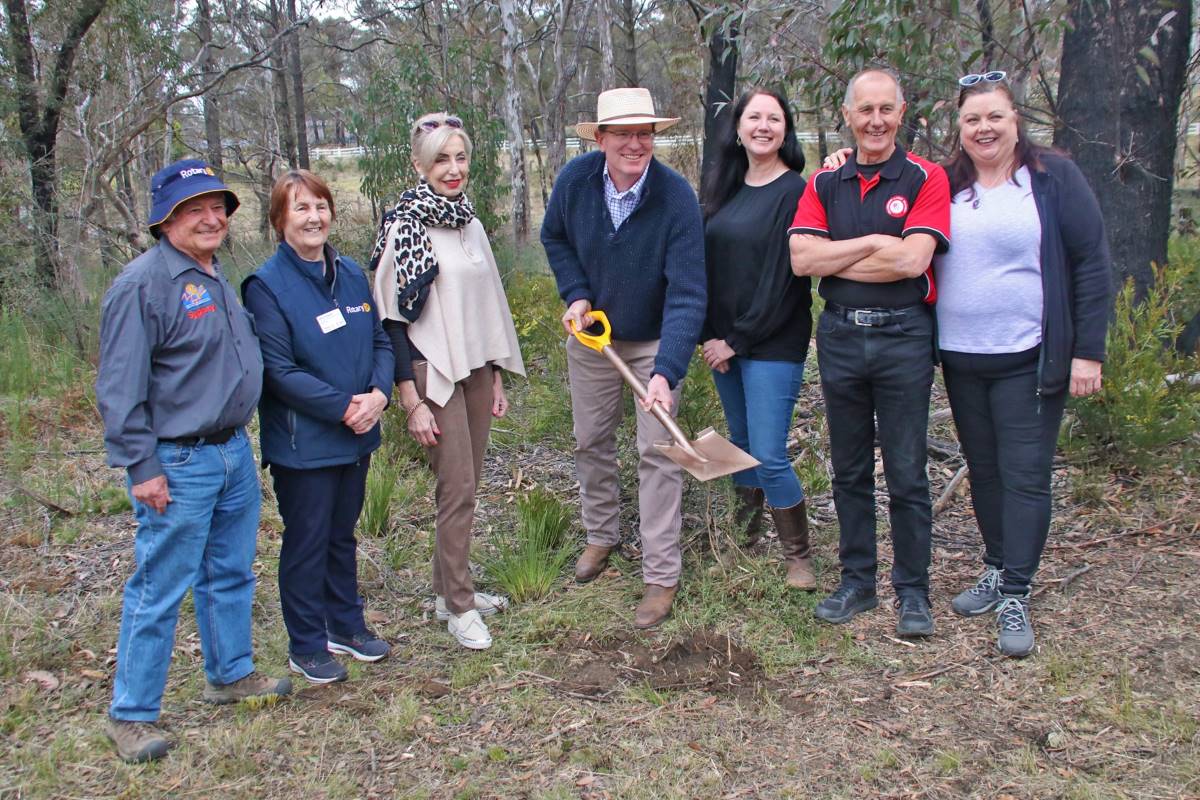
L to R: Rotarian Phill Isaacs OAM, Mina Howard (former Rotary DG) , Lithgow Mayor Maree Statham, the Hon Andrew Gee MP, Kat Boehringer (former ABCD Inc. President), ABCD Committee members Kevin McClusker (President) and Susan Alexander. (Photo: Michael Small)
The first year was spent setting up governance frameworks and communications. “There was no systematic way to share information and communicate,” Kat says. People living out here enjoy their privacy. Some people don’t have a mobile phone or internet. That’s when we rely on ‘sneaker net’,” she says: “A physical note, informal gathering, or a friendly visit”.
There was an existing Facebook page. It was followed by letter box drops and an email distribution list. The first edition of the The Local Lyrebird was published two years after the fires and the ABCD Inc. website was launched.
The fundamentals
Kevin says one of the most important lessons they have learnt is that community resilience relies on keeping people engaged. “You need an association that regularly touches base with as many people as possible. What’s critical though is that it’s in a way that works for them.
“We ask questions like: Are you fire ready and have you got everything you need? If you want to find out how to make your property more fire resistant, you can attend this workshop, watch these videos online, or get assistance developing a bushfire plan.”
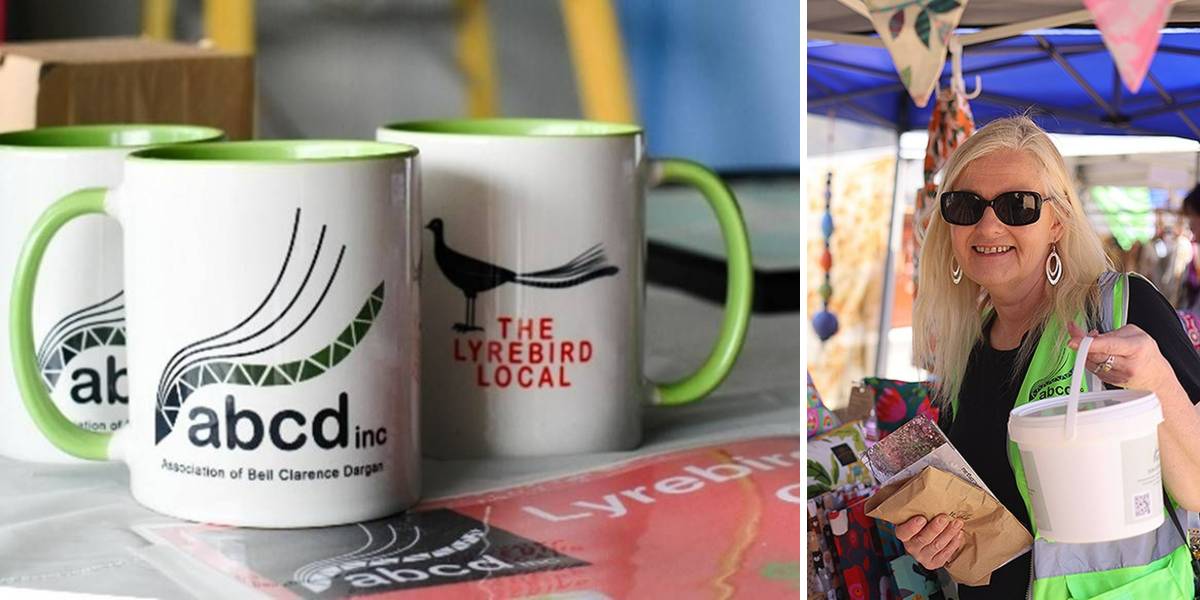
ABCD Inc. branded coffee mugs and ABCD Inc. committee member Cathy MacNamara fundraising at one of the markets (Images supplied)
Kat explains this strategy needs to be complemented by developing community cohesion. This is where community halls, markets, and other social events come into their own.
“Community resilience is underpinned by communication and connection,” she says. “Without this, messages about preparedness can fail to land. A cohesive community also develops the power of foresight. It’s not just when the fire is on your doorstep that you realise you need to be prepared.”
Rotary magic
After the first year, the committee looked outward to build relationships and secure services and funding in a coordinated way. “We were surprised that our application for Black Summer funding got rejected,” Kat says. “Despite the widespread devastation and need, we hadn’t earned our stripes at that stage.”
The first lifeline came from Rotary. Two substantial grants were secured by Mina Howard, Rotary’s District Governor at the time and Leura Sunrise Rotarian Phill Isaacs OAM. This is funding the shell of the new community hall, as well as water tanks, the toilets and the hall kitchen.
A $400,000 grant auspiced by Lithgow Council will enable the fit out of the building to be completed. “ABCD Inc. and Lithgow Council have developed an excellent working relationship,” Kevin says. “It’s a situation where we’re co-managing the build.”

Construction has begun on the ABCD Inc. community hall. (Image supplied)
“The hall is one of the central pillars of our recovery strategy,” Kat continues. “People from the villages can come together and get to know their neighbours. For example, we can hold our annual bushfire healing ceremony there. We can come to socialise too, and for workshops and events. As a post-emergency and recovery hub, it’ll be solar equipped with water tanks, kitchen facilities and communications technology such as satellite WiFi.”
Bushfire preparedness
Building on its success, ABCD Inc. was able to secure a grant from the Disaster Risk Reduction Fund (DRRF). This money is being used to finance a range of bushfire preparedness activities. These include UHF radio training, bushfire consultant sessions, a multi-pronged communications platform and support for vulnerable people. Kevin says having a bushfire consultant come in has been the centrepiece of their bushfire preparedness activities.
“People in the community volunteered to have their house assessed by fire consultant Tony Hawkins. We advertised this and other people joined as observers. Tony talked about what people could practically do to make their homes more fire resistant. The great thing was people started thinking about their own homes. We had great feedback that people were talking to their neighbours and comparing notes. It’s something that’s practical,” Kevin says, “The residents have embraced it.”
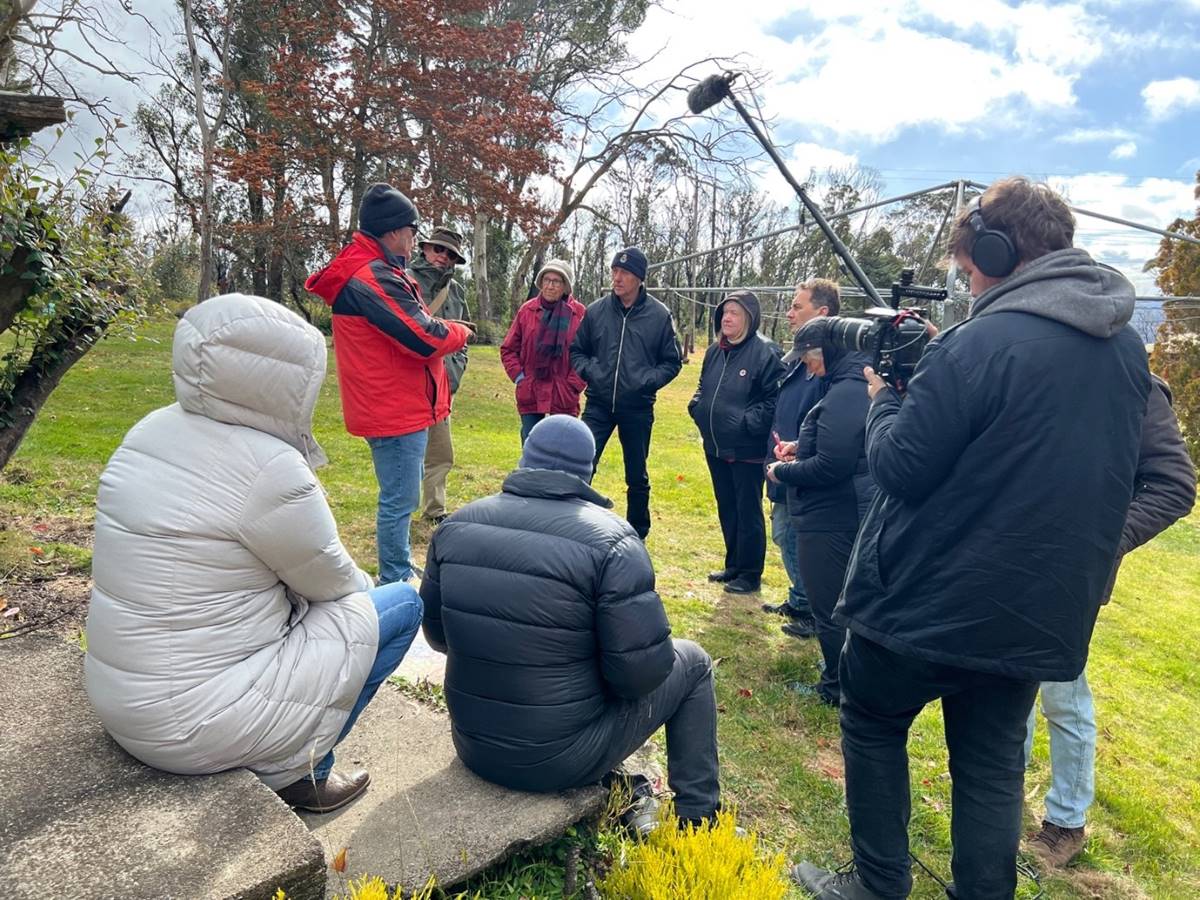
Tony Hawkins talking to residents at the bushfire preparedness workshops. (Image supplied)
“They organised for there to be a videographer at all the sessions. The Disaster Risk Reduction Fund (DRRF) money has paid for the editing of that footage. There are going to be a series of videos available online for anyone who wants to see firsthand how to make their house more fire resistant, especially against ember attack.” Resilient Villages has also supported ABCD Inc. events by providing catering and a facilitator.
The establishment of a Resilience Action Plan (RAP) has been supported by DRRF funding as well. Kevin is excited about its development. A community workshop was held in November last year to further the plan. It was attended by residents and experts from organisations including the local and area RFS and Lithgow Council.

ABCD Inc. Vice President, Dargan resident Karen Cody presenting at the Resilience Action Plan workshop (Image supplied)
“The workshop was designed to generate a collective understanding of our risk of bushfire and to identify and prioritise ABCD Inc.’s next round of activities,” Kevin says. “For example, supplying new residents with a bushfire welcome pack.”
A RAP report provides a way for the communities to connect into government organisations and funding bodies. “It‘s something that enables us to potentially have input into councils’ bushfire management plans,” he says. “A place where community knowledge and needs meet with organisational expertise.”
People make the world go round
At the heart of this story are enormously generous, highly motivated, skilled people. Without them, there would be no local consultation, no local voice and no local understanding that addresses the hearts and minds of the communities. However, without communities to service and a willingness among residents, very little would have been realised.
“We’re incredible proud of what we’ve achieved,” Kat says. “Our communities have come together and we’re more connected and more bushfire prepared than we’ve ever been.” Kevin concludes, “It’s exciting to see how our community’s capacity to prepare, respond and recover from disaster is growing. The community hall will be an amazing resource for everyone and there are more exciting initiatives to come.”
About the people
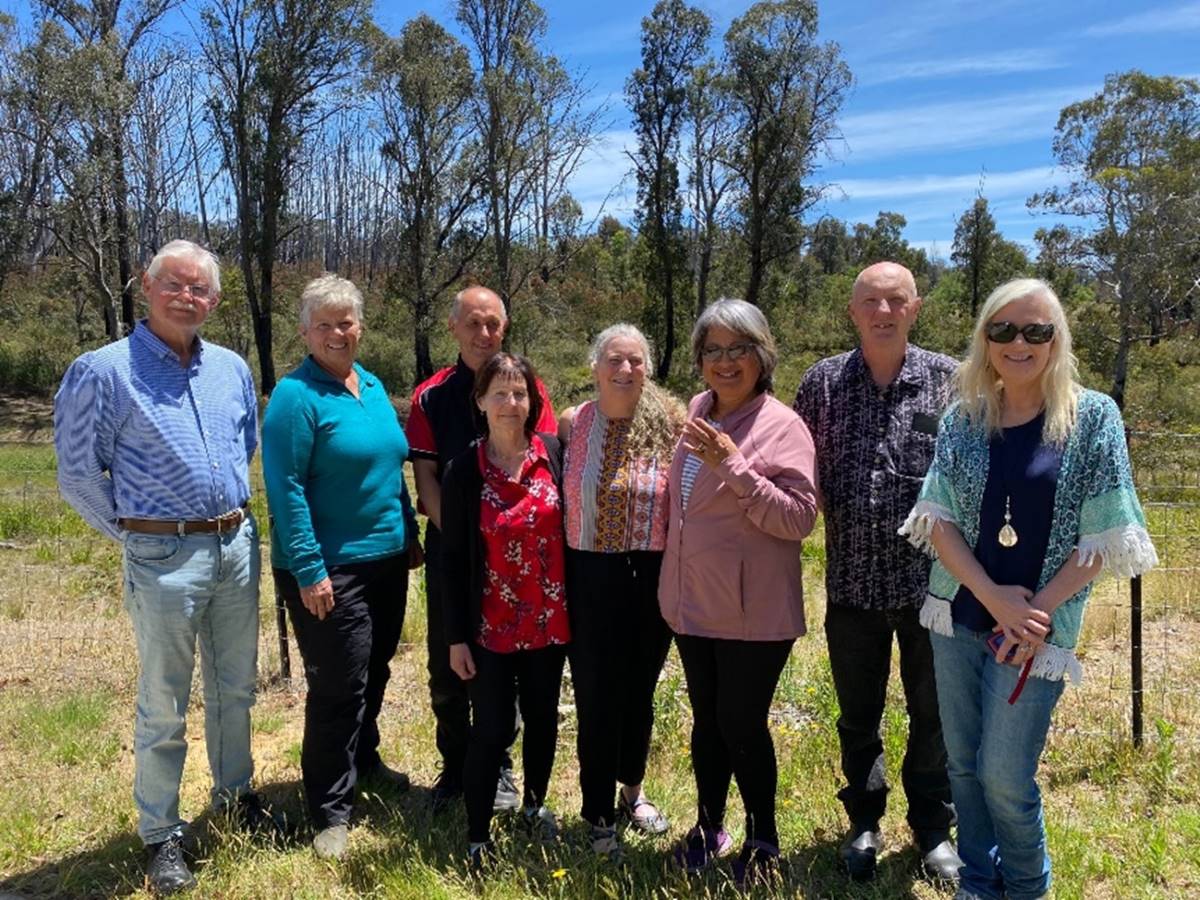
Current ABCD Inc. committee L to R Mark Turl, Karen Cody, Kevin McCusker, Karen Jones, Jeannie Dare, Alice Reti-Steel, Jim Burgess and Cathy MacNamara
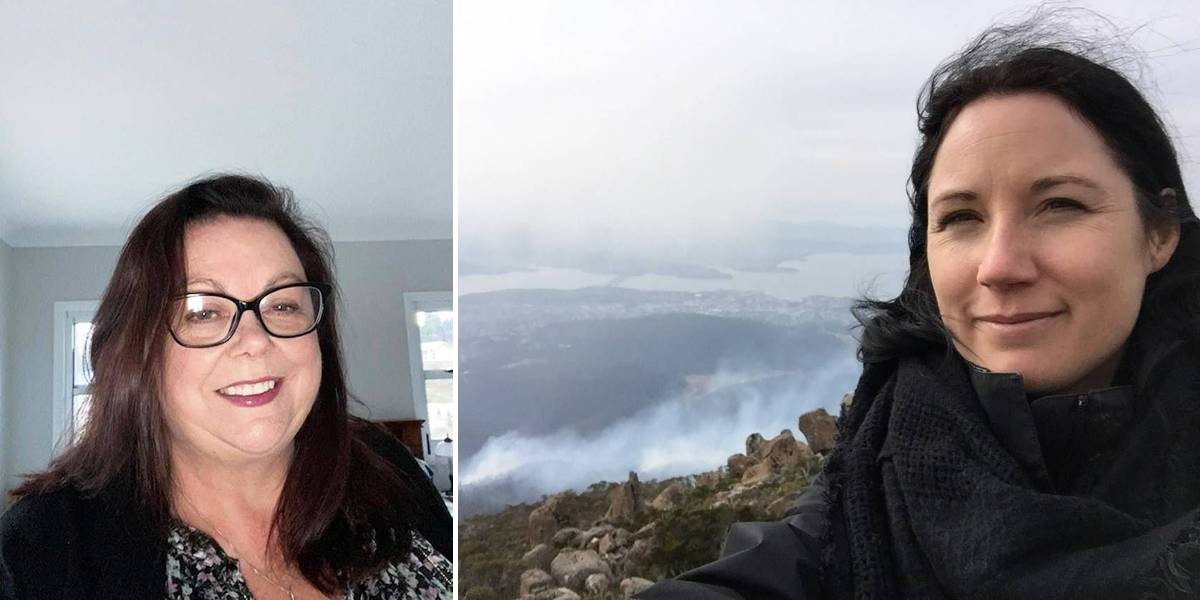
L: Susan Alexander (former ABCD Inc. secretary) R: Kat Boehringer (former ABCD Inc. president) (Images supplied)
People power
The committee that formed ABCD Inc. included Kat Boehringer (President), Kevin McCusker (Treasurer), Susan Alexander (Secretary), Karen Cody (Vice President), Cathy MacNamara, Morgan Boehringer, Eva and Sandy Benson. Kat and Susan recently stepped down from their positions and Kevin has become president.
New committee members include Mark Turl from Bell and Karen Jones, Jeannie Dare and Alice Reti-Steel from Clarence. Jim Burgess who is on the hall sub-committee will continue to be an ex-officio committee member. Kevin says that Kat and Susan can’t be thanked enough for their time and energy, and is pleased that they remain actively involved in the community, including with the local RFS brigade and communications sub-committee.
Kat, Karen Jones and Cathy are all communications and marketing professionals. This capacity was key to developing and maintaining all the communications infrastructure including The Lyrebird Local, organising markets and events, and advocating and fundraising for the new community hall. Cathy has also played a key role in facilitating people to tell their personal stories. Karen and Kevin have been the driving force behind the bushfire preparedness activities including workshops, bushfire consulting and the RAP, along with Susan, who is leading a community phone tree initiative.
Mina Howard and Phill Isaacs OAM were the first people to align with ABCD Inc.’s vision. Phill has also played a key role in getting approvals and building certificates for the hall. “Phill is a true powerhouse and a genuinely caring and generous individual,” Kat says. “He’s made a massive contribution.” Karen Jones’ husband Dennis, an engineer by trade, is project managing the hall build. Regional funding bodies, community service organisations and the state Disaster Risk Reduction Fund have made invaluable contributions.
Lithgow Council has been supportive though grant management and retaining the land on which the hall is being built. Blue Mountains City Council has also contributed funding to post-fire planting initiatives in Bell. Resilient Villages and the Foundation for Regional and Rural Renewal (FRRR) have made important contributions, along with State and Federal MPs representing the two LGAs, who have all lent their support in different ways.
Share this article:
This story has been produced as part of a Bioregional Collaboration for Planetary Health and is supported by the Disaster Risk Reduction Fund (DRRF). The DRRF is jointly funded by the Australian and New South Wales governments.
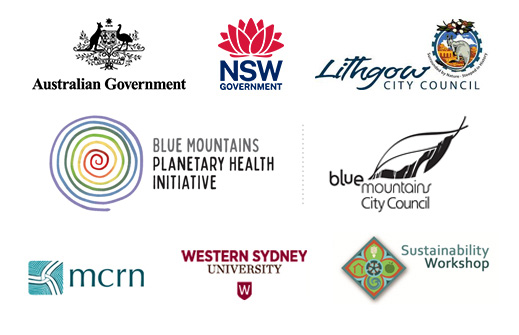
More from around the region
Did you know that old lino, window putty, and adhesive can contain asbestos? Yesterday the Asbestos & Hazardous Materials Management Conference kicked off with a pre-conference workshop at the Blue Mountains Planetary Health Centre. It included hands-on `spot the asbestos` and asbestos sampling sessions. This year`s theme is `Working together for a safe and healthy future`. #asbestos #hazardousmaterials #conference #planetaryhealth #bluemountains #katoomba
A huge thank you to Josh Logan from Logan Signs, Lithgow, for installing our Circular Water Signage in time for our World Animal Day Celebration today at the Blue Mountains Planetary Health Centre (33-39 Acacia St Katoomba). We have a full program of events with lots of information on how to prepare for the summer ahead and how to create urban areas that help us share our home respectfully with all species. It will be a fun family day too with storytime, craft and live music for kids! (Link in profile) #worldanimalday #planetaryhealth #familyday #katoomba #bluemountains
And our Wild Life exhibition is now up for World Animal Day tomorrow at the Blue Mountains Planetary Health Centre. Photographs by Warren Hinder, Merryl Watkins, Holly Kent and Tracy Burgess. Check out all the other events from stalls, talks, possum box demo, kid`s craft and animal storytime, plant based food and live music to Bushcare. @33-39 Acacia St Katoomba Link in profile. #planetaryhealth #worldanimalday #katoomba
Join the Blue Mountains Planetary Health Initiative at World Animal Day this Saturday 5 October for a discussion on the history of the Plant Based Food Movement in Australia and a discussion of exciting contemporary trends. It will be followed by a Plant Based Cheese Degustation to launch the Plant Inspired Community Cooking Project. This will be a series of cooking classes to introduce the community to plant based cooking techniques. The event is free but places are limited so bookings essential (link in profile): https://bit.ly/3Bzbwhu
#plantbasedcooking #worldanimalday #bluemountains #katoomba #planetaryhealth #communitycooking
We share the Blue Mountains with so many extraordinary beings but have you seen them and do you know their names? Do you know the difference between a Royal Spoonbill and an Eastern Shrike-tit, or the difference between a bandicoot and an antechinus? Come and check out our Wild Life Exhibition at World Animal Day this Saturday to learn more from the stunning photographs by Warren Hinder, Merryl Watkins, Holly Kent and Tracy Burgess. There will be also be a Breakfast with the Birds at 8.30am, Animal Storytime and Craft for kids from 10am, stalls, talks, food and live music. The day is free but please book via Eventbrite to help us cater (link in profile): https://bit.ly/4eMhbz0 @bluemountainswalks @merrylwatkinsphotography @bestofbluemountains
#royalspoonbill #easternshriketit #wildlife #birdsofthebluemountains #bluemountains #katoomba #worldanimalday #biodiversity #planetaryhealth
To coincide with the first day of Bushfire Season we launched Air Watch at the Planetary Health Centre yesterday. For the last seven years Blue Mountains Unions & Community have been working tirelessly to ensure residents of the Blue Mountains and Lithgow are able to measure and track the quality of the air we breathe. The Blue Mountains Planetary Health Initiative has worked closely with them over the last year and now there are 20 PurpleAir monitors distributed throughout the Blue Mountains and Lithgow, including one at the Planetary Health Centre. You can now view real time air quality measurements at each of our local news sites and on the Purple Air Map https://map.purpleair.com We have 10 more sensors available, so if you’d like to install a sensor, members of BMUC will be at World Animal Day at the Planetary Health Centre this Saturday 5 October to take applications and share more information about the project. Bookings for World Animal Day here (link in profile): https://www.eventbrite.com.au/e/world-animal-day-promoting-respectful-cohabitation-tickets-1029328889417
It was a fabulous day yesterday as each speaker highlighted how critically important this project is: Dr Rosemary Dillon CEO of Blue Mountains City Council Trish Doyle MP Dr Jenna Condie from Blue Mountains Parents for Climate Dr Maggie Davidson, environmental scientist from Western Sydney University Matthew Riley, Director Climate and Atmospheric Science from NSW Department of Climate Change, Energy, the Environment and Water and Peter Lammiman and Ann-Maree McEwan from the BMUC’s Airwatch Committee.
@bluemountainsunionists @nswdcceew @bluemountainscitycouncil @westernsydneyu @trishdoylemp @parentsforclimatebluemountains #airqualilty #airqualitymonitors #bluemountains #planetaryhealth
Treat yourself this weekend with a fun-filled and informative World Animal Day event at the Planetary Health Precinct in Katoomba. As well as a Breakfast with the Birds, stalls and a possum box demonstration, there will be a fabulous wildlife exhibition with photos by Warren Hinder, Merryl Watkins, Tracy Burgess and Holly Jayne; live music with Mem Davis, Joe Flood and Duck Keegan; lots of fun for kids with Sharon Baldwin and Naomi Crew leading animal storytime and craft with Julie Refferty; delicious plant based, gluten and dairy free treats, pastries and donuts from Clean Cravings; a plant based cheese degustation and warming Dahl, rice roasted cauliflower with veggies, pakoras, tamarind chutney, and salad courtesy of Bibi’s Kitchen. Come and learn more about Blue Mountains Bird Observers, Blue Mountains Conservation Society, WIRES, Action for Animals Blue Mountains and Animal Sanctuaries, Wombat Rescue, the Women’s Shed, and Animal Welfare Laws in Australia.
Guest speakers throughout the day will include Elizabeth Ellis, lecturer and author of Australian Animal Law; Hal Ginges, a local lawyer and animal activist from Action for Animals who advocates for animal rights and raises money for sanctuaries; Mark Berriman who has been President of the Australian Vegetarian Society NSW since 1989, as well as Co-ordinator for Animal Liberation NSW, Director of the Natural Health Society of Australia and the World League for Protection of Animals; and Teya Brooks Pribac, a researcher in the area of animal studies and the award-winning author of Enter the Animal. She’s also published Not Just Another Vegan Cookbook and will be sharing her culinary skills with the community in the Plant Inspired Community Cooking Project.
The event is free but please book your place to help us cater (link in profile): https://www.eventbrite.com.au/e/world-animal-day-promoting-respectful-cohabitation-tickets-1029328889417
#worldanimalday #plantbased #planetaryhealth #katoomba #bluemountains
We are so looking forward to kicking off World Animal Day Celebrations on Saturday 5 October with an 8.30am Breakfast with the Birds. Join Paul Nagle from the Blue Mountains Bird Observers on a guided bird walk around the Planetary Health Precinct visiting different habitats on the site to observe and talk about the birdlife that is resident and that visits the site. Binoculars are highly recommended.
World Animal Day will be an inspiring family day celebrating the extraordinary diversity of animals we share our world with! The theme is `Promoting Respectful Cohabitation`. Bookings for the Breakfast with the Birds (link in profile)
or here:
https://www.eventbrite.com.au/e/breakfast-with-the-birds-tickets-1028664983657
#birdlife #breakfastwiththebirds #katoomba #worldanimalday #bluemountains #planetaryhealth #respectfulcohabitation
We all need clean air to breathe, but how can we tell how clean our air is?
Thankfully the Air Watch subcommittee of Blue Mountains Unions & Community has worked for years to find ways to help us measure the quality of the air we breathe. Over the past year the Blue Mountains Planetary Health Initiative has worked with them to install Purple Air Quality monitors across our bioregion from Lithgow to the Lower Mountains. You can now view real time air quality on each of our Local News Sites!
Air Watch`s Purple Air quality monitors give the Blue Mountains` 78,000 residents, workers and 3 to 5 million/year visitors the power to make timely, informed decisions about their activities and health. It will also be a reliable source of data for the scientific community.
To coincide with the start of the Bushfire Season on Tuesday 1 October, we`re inviting the whole community to join us to launch Air Watch Blue Mountains and Lithgow at the Planetary Health Precinct. If you`d like to join us book a place here https://bit.ly/4dp2qko (link in profile)
#airquality #purpleair #bluemountainsunionscouncil #planetaryhealth #bluemountains #katoomba #bushfireseason
Today`s the day for the Blue Mountains Sustainability Festival! @bluemtns_sustainability_fest
We`ll be at the Speakers Forum at the Blue Mountains Cultural Centre at 10.15, talking about volunteer opportunities with the Blue Mountains Planetary Health Initiative, and then giving a presentation at 2.30pm. There`s a jam-packed speakers program, community stalls and workshops, and a Shopping Trail through Katoomba and Leura. You can find more information on the website at https://resilientbluemountains.org/sustainability-festival/
#sustainability #slowfashion #slowshopping #fashiontrail #circulareconomy #planetaryhealth #community #katoomba


